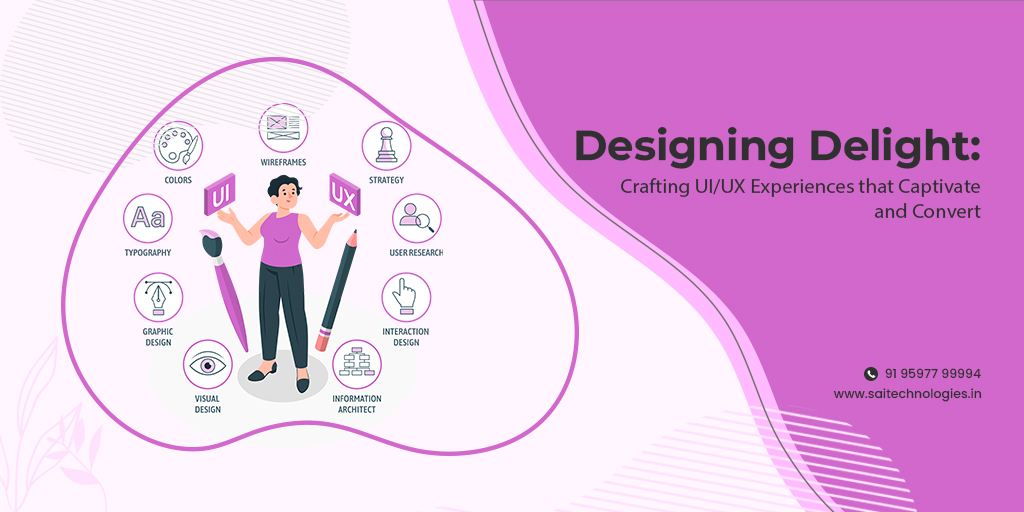Designing Delight
Crafting UI/UX Experiences that Captivate and Convert

In the digital landscape, where user attention spans are shorter than ever, the design of a website or app can make or break its success. User Interface (UI) and User Experience (UX) design play a pivotal role in creating meaningful and memorable interactions that not only captivate users but also drive conversions. This article delves into the world of UI/UX design, exploring how the seamless marriage of aesthetics and functionality can create experiences that leave a lasting impression and inspire action.
The Essence of UI and UX Design
Defining UI Design:
User Interface (UI) design is the art of creating the visual elements that users interact with on a digital platform. It encompasses everything from the layout and typography to color schemes and icons. A well-crafted UI design ensures that the user interface is visually appealing and intuitive
Defining UX Design:
User Experience (UX) design, on the other hand, focuses on the overall experience a user has while interacting with a website or app. It involves understanding user behaviors, needs, and pain points to create seamless, user-centered journeys. UX design aims to make interactions effortless and delightful, ultimately leading to positive outcomes.
The UI/UX Synergy: Creating Captivating Experiences
Aesthetic Appeal and Functionality:
The marriage of aesthetics and functionality is at the heart of UI/UX design. A visually pleasing interface combined with intuitive navigation enhances user engagement. Each element, from buttons to images, is strategically placed to guide users through a seamless journey.
Consistency and Brand Identity:
Consistency in design elements, such as colors, typography, and icons, reinforces brand identity. When users recognize familiar design patterns, it builds trust and a sense of familiarity.
Crafting Captivating UI Experiences
Visual Hierarchy:
Designers strategically use visual hierarchy to guide users' attention. Elements like bold headings, contrasting colors, and size variations help users navigate content effortlessly.
Whitespace:
Whitespace, or negative space, is a powerful design element that enhances readability and focus. It gives the eyes room to breathe, making the content more digestible.
Orchestrating Seamless UX Journeys
User Research:
Successful UX design starts with understanding users. Through user research and personas, designers gain insights into user needs, behaviors, and pain points.
User Flows:
Mapping out user flows helps designers anticipate user actions and design intuitive paths. This lessens friction and improves the experience as a whole.
The Impact of UI/UX on Conversions
Clear Call-to-Actions:
UI/UX design directly influences call-to-actions (CTAs). A well-designed CTA stands out, prompting users to take the desired action, whether it's making a purchase, signing up, or downloading an app.
Reducing Friction:
A seamless UX eliminates obstacles that might discourage users from converting. A cumbersome checkout process or complicated forms can lead to abandoned carts or user drop-offs.
Embracing Responsive Design: A Multi-Device Approach
Mobile-First Design:
With the majority of users accessing digital platforms on mobile devices, mobile-first design is essential. It ensures that the interface and content are optimized for smaller screens without compromising functionality.
Responsive Design:
A responsive design adapts to various screen sizes, ensuring a consistent experience across devices. This versatility enhances user satisfaction and engagement.
Trends in UI/UX Design: Evolving with the Times
Microinteractions:
Microinteractions are subtle animations or feedback that provide a sense of delight and responsiveness. They can include a button changing color on hover or a notification animation.
Dark Mode:
Dark mode has gained popularity due to its aesthetic appeal and reduced strain on users' eyes, especially in low-light conditions.
Testing and Iteration: The Ongoing Journey
User Testing:
User testing involves real users interacting with the design to identify pain points and areas of improvement. This iterative process leads to refinements that enhance the user experience.
Data-Driven Design:
Analytics and user behavior data provide valuable insights into how users interact with the design. These insights guide informed design decisions.
Conclusion: Crafting Digital Experiences that Leave a Mark
In the digital realm, UI/UX design is more than just aesthetics; it's about creating experiences that resonate with users and drive desired outcomes. The synergy between UI and UX design elements creates captivating interfaces that guide users effortlessly. By understanding user needs, crafting seamless journeys, and continuously refining the design through testing, designers can create digital experiences that captivate, convert, and leave a lasting mark in the hearts of users. In a world where the digital landscape is ever-evolving, the power of UI/UX design remains an enduring force that shapes the way we interact, connect, and engage online.

